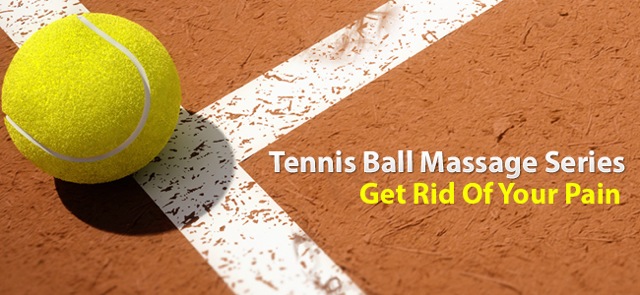
Your lower body should be loose as a goose right now. It’s time to move onto the upper body. If you haven’t done so already read Part 1 and Part 2, to find out all you need to know about trigger points and how to work them in your lower body. Part 2 also gives you some information on what to do before and after each trigger point session.Read them? Good, now we can move onto some tight and painful areas in the upper body.
If you want more information on how to find trigger points and how to get them with a tennis ball, then check out the review of the self massage guide.
I have had a lot of emails asking about the massage ball that I am using, like I said a tennis ball works great, but you can get the exact ball I am using here on amazon. There are a few other sizes too, check them out here: Spiky Massage Ball
1. The Psoas
This is a tough one to actually get trigger points done with the tennis ball, however this kind of work will give it a good release. The Psoas is often tight from people sitting down at work all day and having it in a shortened position.
How To:
About 2 cm right from your belly button is the initial place you want to put the ball. Lay flat and gradually raise yourself up of the ground. The higher you go the more stretch and consequently more pressure you put through your Psoas. Repeat this with the ball in the same spot a few times, then move it up and down slightly. Test out each area of the Psoas and find where you are tightest. Not everyone will feel something from this exercise, if you are tight in the Psoas I find the best way to get nice and deep where you need is some hands on active release work or acupuncture. However this is a good, cheap and convenient start!
2. The Erectors
We all tend to have pretty bad posture when we are sitting, and we can develop tight erectors (these are the long muscles that extend from your lower back right up to your neck on either side of the spine). You probably won’t find many trigger points in this exercise but, the thoracic and cervical (upper) erectors are where you want mobility and are often very tight, so that is where we will work through.
How To:
Place two tennis balls in a sock (it’s OK guys, they are very cheap…) and place it on the ground behind you. Lay down slowly and extend over the two balls. Start around where I have in this picture. You will find they fit perfectly onto your erectors and the groove between the two balls leave enough room for your spine. Once you have extended over an area, sit up, shift forward slightly, and come down again over the next vertebrae. Do this right up your back. As I mentioned before this isn’t really trigger point work, but since it’s a tennis ball post I had to include it. So many people have bad posture, this will help to straighten you out and hopefully reduce back problems.
3. The Trapezius
For whatever reason I am betting you have tight traps. These are the bulges of muscle on either side of your neck. Go on and touch them right now and I bet they feel like rocks. People tend to get tight traps from sitting with a bad posture, stress, lifting and simply everyday life. Your traps run right down to you middle back, but it’s the top area that you will find are generally tighter.
How to:
There are two ways you can approach this. Firstly, you can put the ball on the ground, lay back and find the spots on your traps that are the tightest. Move your body around by pushing from your legs. Try to relax your neck and head.
You have lots of trigger points in this area, however you might find that the overall muscle is simply too tight and you need to loosen it first before you can get specific trigger points.
Some people may find this a little awkward so…
You can also get a sock, and place a tennis ball in it. Then, standing against a wall, place the ball where you want it, hold the sock and start searching for your spots. This can often be easier as you are able to move the sock around whilst you are putting pressure on the ball. Either way is good and try both to see what suits you best.
4. The Pecs
Sitting at your desk and using your computer leaves you with tight pecs. Your shoulders are often in a rounded position and your pec major and pec minor want to stay in that shortened position. Let’s not even touch on the fact that most people are bench press dominant when they go to the gym. Point is, these get tight, and need to be released for optimal shoulder health.
How To:
Yes, I look a little like a dead fish, but it’s the most effective way to get at these babies. You will find the best response comes from the upper pecs, where the muscle starts to get smaller and go into your shoulder. It’s a big muscle, so play around. Lay on the ground with the ball underneath you. Roll around a little until you find tight and tender spots, then hold. This is a pretty painful one, but very necessary in almost everyone.
5. The Rotator Cuff
The rotator cuff consists of four muscles. The infraspinatus, teres minor, subscapularis and supraspinatus.
The only two you can really access are the infraspinatus and the teres minor, they sit on the back of your scapula and can be palpated through the skin. These are both external rotators. The other two are very deep and can really only be located by a specialist. Rotator cuff tightness and trigger points are a very common cause of shoulder pain. Bad sitting posture, keeping your arms overhead a lot, using the mouse with one hand and typing with no elbow rest can cause these can become very tight. This can help to relieve a pinched nerve in shoulder.
How To:
First you need to locate the infraspinatus and teres minor. These sit smack bang on the meat of your shoulder blade. Check out where mine is (see the red marks from some tennis ball work!)
You then lay on the ball, one your side. You will find that your shoulder blade moves round to be underneath you and will be able to sit nicely on top of the tennis ball. Move around slightly to see where you are tighter. As you can see from the first diagram, the infraspinatus is quite long. I find that I have more troubles up closer to where it is about to go into the shoulder, and that is where I do more work through. Try the whole length of the muscle for yourself. Once you have found a spot, lay there and don’t move. These muscles are very tight and will respond.
For some extra work, hold your arm in the two positions I have below and internally and externally rotate your shoulder. Do this about 1o times. You should feel the pain slowly getting more bearable. The ball won’t move, so you will be staying on the trigger point or sore point, and you will be giving yourself some very cheap and easy active release therapy. This does wonders for loosening up your rotator cuff and keeping your shoulders healthy.
Try this position with your arm as well.
A quick video showing the release.
If you don’t have pain, get into these spots around once a week anyway. Most of us are tight and dont even know it. If you are tighter in some areas or suspect that an injuryor pain is being caused by trigger points, do this as much as you want. There are no harmful side effects, other than a little soreness after the first few tries. You will only feel better. I suggest if you aren’t already doing so start foam rolling. You can consider this the next step up! Both in pain, and benefits.
Now you can keep your lower and upper body loose and mobile. Optimal muscle function is critical to your exercise program. Not only will you feel better, you will recover faster and be able to work a little harder in the gym. By getting into these spots you are ensuring that you are doing your best to prevent many overuse injuries. I can guarantee after a session with the tennis ball you will be feeling better than you ever thought possible.
Part 1: A Tool You Never Knew You Had
If you liked this post and suffer from muscle and joint pain, then you need to check out the Ultimate Self Massage Guide. It details exactly how to release all the important muscles in your body with a tennis ball and foam roller. This knowledge will enable you to treat your own pain at home, get rid of your symptoms without spending money on a therapist, and move and feel better.
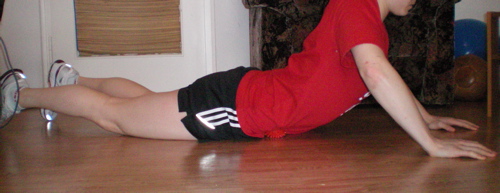

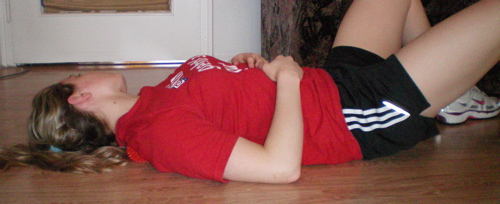
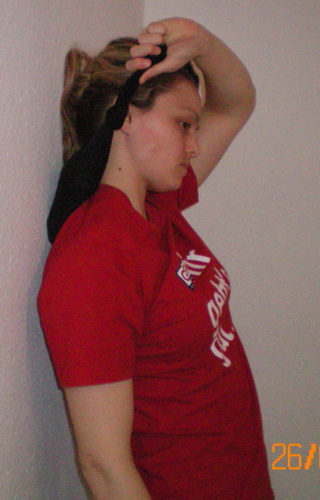

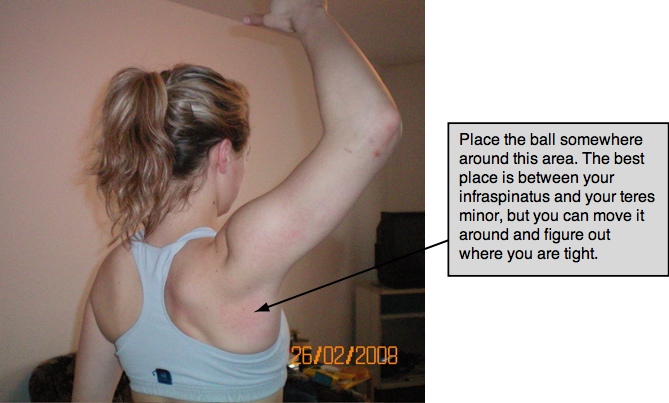


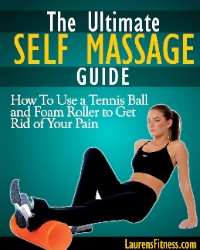
Mehdi says
Great stuff Lauren 🙂 stumbled!
Lauren says
Cheers Mehdi!
Susan says
Great info! I get very tight in my upper back, partly from bad posture and partly from stress. Deep tissue massages are great, but yes, the cost can add up over time!
I will have to try some of these trigger point exercises, especially the trapezius and erectors… as soon as I find a couple of tennis balls, that is! 🙂
Lauren says
Thanks Susan! Good luck with it, I really feel it does wonders. Hard to cause yourself so much pain though!
Cheers.
Posture Exercises says
A good old tennis ball can be a great tool to work into some tight muscles. Sometimes it really hurts but it works very well. Thanks for the pics to see how you work different muscles.
tim says
Hi Lauren,
Sorry, this isn’t related to the article although it was a great read.
I’m currently in year 12 and am interested in strength and conditioning. Next year ill be going off to Uni and would like to chose something that I will like. I understand that you have a degree in Human Movement and are currently doing a Masters Degree in Strength and Conditioning, and was wondering if you knew of any courses in Sydney. I had a look a Sydney Uni which offered sports science which sounded cool, have you heard of any others? Thanks very much.
Philip says
Great article. Most people do not know the benefits of massage therapy, or if they do they are unable to afford it on a consistent basis. This provides many of the benefits at close to zero cost. As a side effect, trigger points are fun to play with.
Great article, great pictures.
Lauren says
Thanks!
vman says
hey, just wondered what type of ball you’re using in the pictures?
loving the tennis ball therapy but im finding im going through a lot of balls as the get compressed alot.
Lauren says
just a spiky ball i bought from a local chemist
James says
Can tennis balls be used in the occipital region?
Lauren says
james i would probably avoid it… get someones thumbs in around there its a lot less bulky and they have a lot more fine control
James says
Thanks. That’s kinda what I thought. A chiro once told me to do it, but I thought better of it.
James Suggitt says
Ive just found your website and having had a shoulder injury for the past 3 months thats now stopped me training this article was a saviour! Its made a massive difference to my traps but I was wondering if you could adapt the same principles to the sternocleidomastoid because mines forever playing up on my left side. I realise its my own fault for doing ju-jitsu and having people trying to choke me out but any help you could give would be awsum. Ive tried just about everything prescibable and its made no difference so far.
Lauren says
Hi James,
I would use your fingers for your sternocleidomastoid. Find a tight spot or band, hold it and move your neck to the left and right slowly. This should be a good release. Use your right hand, and try to keep relaxed. Simply rotate your head left and right as if you were looking to the left and right. Even better, get someone else to hold those spots while you move. If you cant find trigger points in particular, guess. The whole thing is probably tight so just work up and down it.
Cheers
Robert says
Wie Gehts ?
Good site. Would recommend getting all injuries assessed by a qualified physiotherapist. Mine recommended work with a tennis ball. This site has explained the why and best practice.
Keep up the good work.
Jezt fuhle mich sehr besser. Vielen Dank.
Ismail Fan says
Doing your psaos stretch immediately relieves some tightness around my lower back area. It’s amazing. Thank you for the good work!
mark says
Hi Lauren, Interesting that you mentioned the two tennis balls working the muscles each side of the spine. I herniated my L4 disc about a year ago and using that to relieve the muscle tension and spasming along the length of my back was fantastic and provided almost instant relief.
Christophe says
Hi,
are there any kind of situations that you would avoid tennis ball massage? Can you do this on any kind of injury?
best regards
Lauren says
No you should avoid it if you have recently torn that muscle.
Vin says
Just want to say that I thank you so much for setting up this site and your articles.
I’m a 24 year old male from Grenada, west indies. I started working out regularly 8 months ago and since then I have made great gains (20 pounds of muscle). Recently I’ve been starting to get pains in my knees, shoulders and wrists which I associate with either bad form or injuries.
Reading your articles on tennis ball ad taking them into practice have made my knees much stronger and helped the imbalance between my hamstrings and quads which I think was causing the problem I had with going up stairs, squatting and sitting with my legs at a 90 degree angle for too long.
One question I would like to ask though is it true that leg extensions (on the machine) and hamstring curls (also machine) can be bad for your knees & joints?
Many thanks!
Vin
Lauren says
i personally don’t like leg extensions because they put awkward pressure on my patella, but in a lot of cases they are useful. Especially for beginning a rehab program after a serious knee injury. Thanks!
Joe says
Have you heard of anyone accidentally hurting internal organs or arteries while trying to massage their psoas with a ball?
Lauren says
No I have not!
Weight Lifting Complete says
Very useful images there. It’s hard to find a good guide on soft tissue work without paying…thank you.
Meltem Tekeli says
Lauren,
Thank you for this very informative series. I am a former ballet dancer and have suffered from mysterious pain down my entire right side for nearly 10 years. It is in a line down the front and back of my body, as well as along the side of my body, up through my right jaw. This occurred after trauma — a right labral tear as well as a torn right ACL. I have been using a tennis ball and a foam roller for years but have not been able to get at the pain that is in the waist and ribs area. It is extremely deep and lies underneath the bone. Is there any exercise you can recommend?
Also, is there anyone in New York City that you could recommend that I see for my fascia issues? Thank you so much for your dedication to this issue.
Meltem Tekeli
Lauren says
Hey I’m really sorry I’m from Australia I don’t know anyone in that area!
This is a very strange pain, send me an email with more details about it and I’ll see how I can help and who I can refer you too.
conor says
Lauren ,I’ve paid lots of money over the years for the information you have kindly shared on your site.My wife and I have tried these exercises and they work . Keep up the good work and thank you.
Lauren says
love this feedback conor thanks!
Joey says
wow that was very informative and will probably save me hundreds of dollars on massage therapy. Thanks bigtime.
doggy style says
lauren you are really HOT!!
Carl@ sciatica exercises says
This is a great guide for using the exercise ball properly to avoid injuries.
Kumar says
Superb stuff and all for free!!! Keep up the good work Laurens !
Carly~ the 10 minute trainer says
I love the stuff you have here. Knowing the right way of doing these exercises is so essential to avoid injuries. And you definitely do it right. Thanks.
Carly
The Personal Trainer says
It’s good to have post like this because doing any exercises without any supervision from an expert could cause some injury, and this post serves as a guide to do it correctly.
Ikram says
Great article Lauren
My joints have been cracking constantly as i do bodyweight exercises more often
Can this help stopping my cracking joints?
Lauren says
It can yes, but it might not. Cracking joints can be from a number of reasons…one may be misalignment of the joint, due to muscle imbalances, in which case some soft tissue work over a long period time could definitely help.
Sonia says
I’ve had a frozen shoulder for 6 months and have read some about the possible relationship between the condition and trigger points. I am going to give your rotator cuff exercises with the tennis ball a try. Hoping it will speed up my recovery.
garfield says
hi. very helpful information, fits my injury exactly (pinched nerve in shoulder, i can only sleep on one side, sore every morning.) the shoulder blade massage brings relief. 6 months ongoing pain, will it ever go away, your diagnosis was spot on. thanks.
kim says
I was wondering about using the tennis balls on the abdomen and ribcage…i have a lot of knots a stuck areas, us this safe for organs etc.?